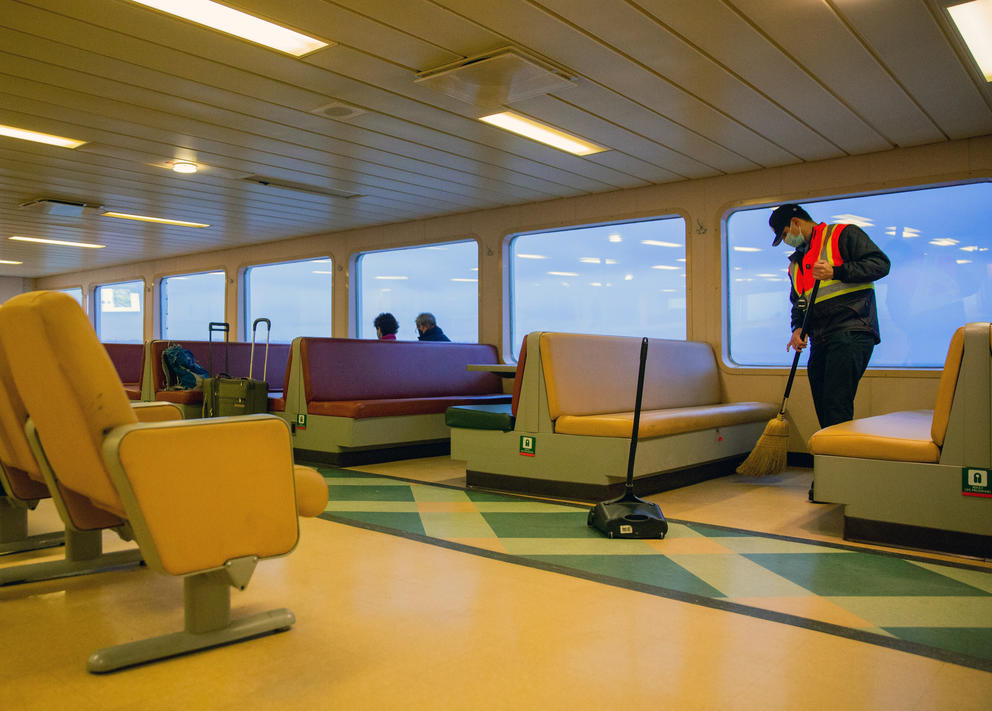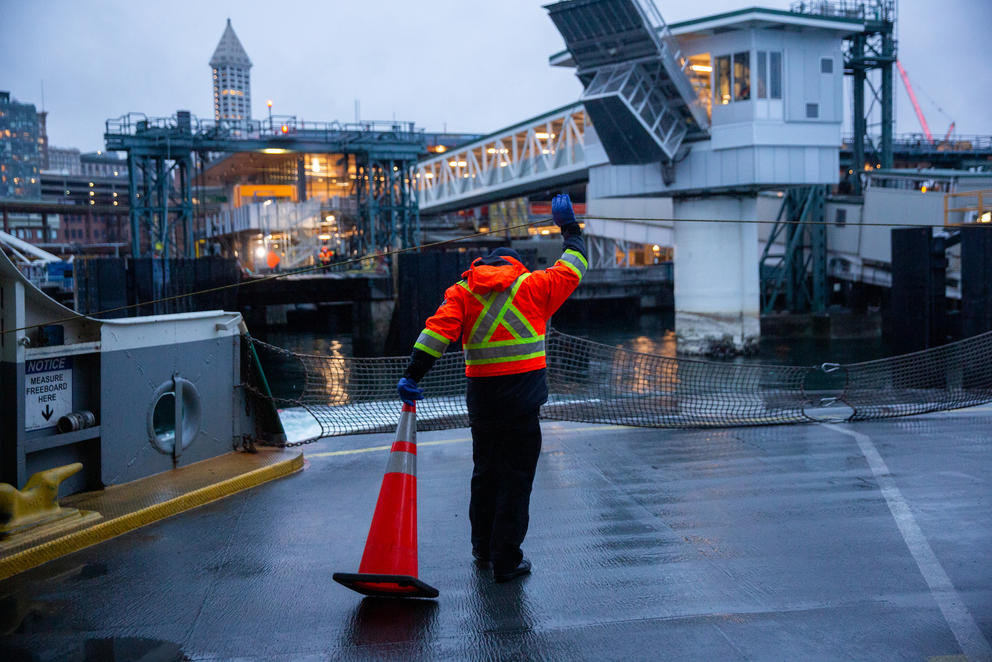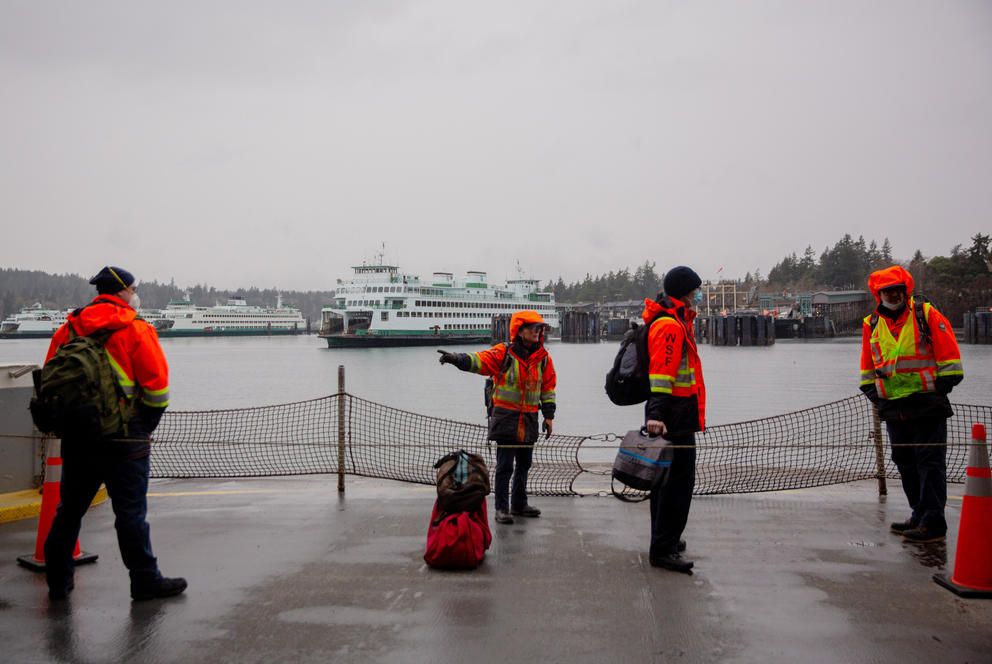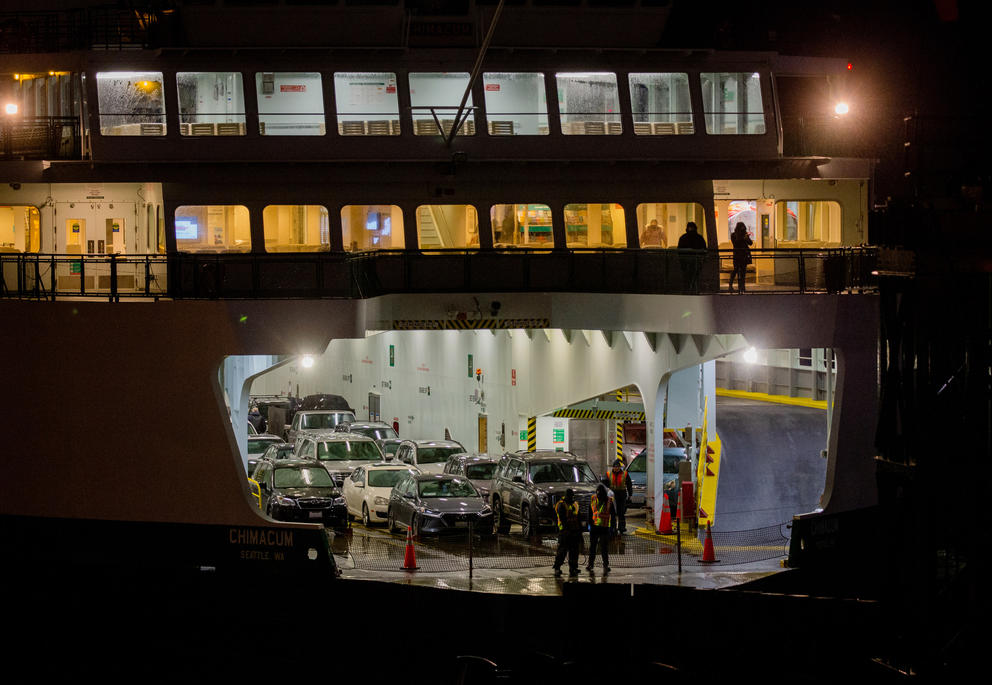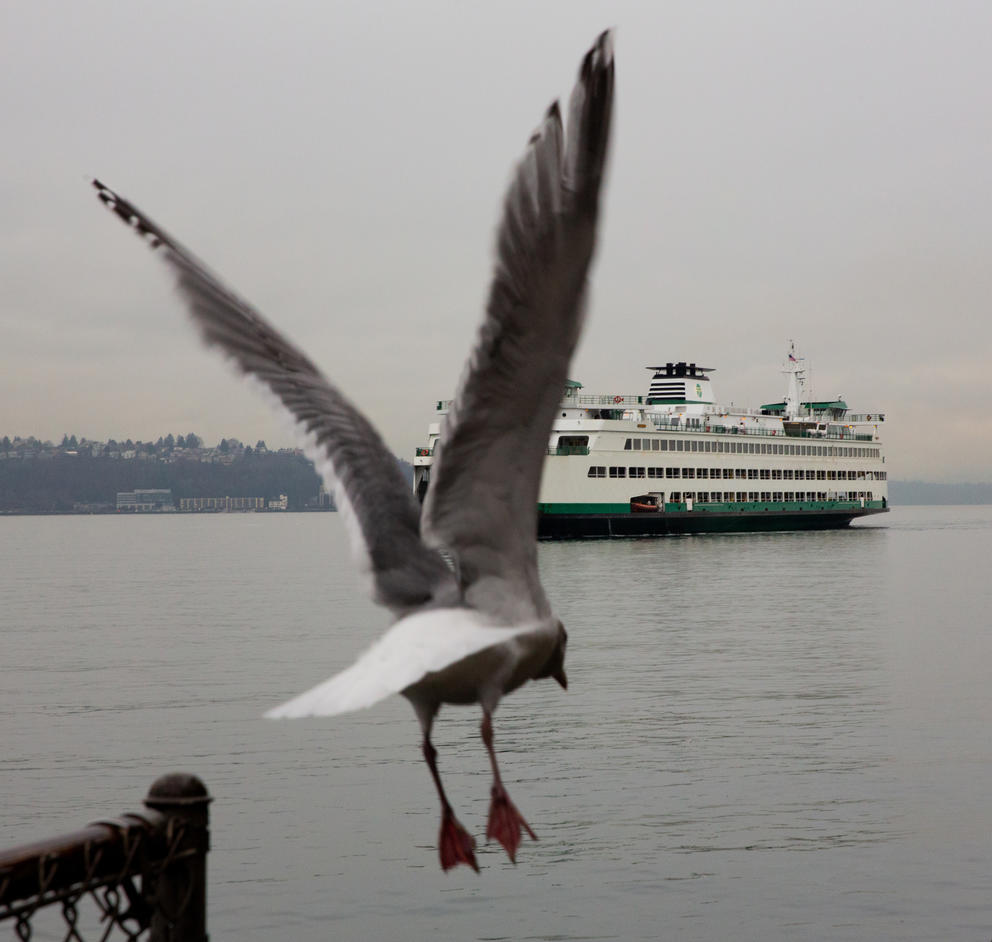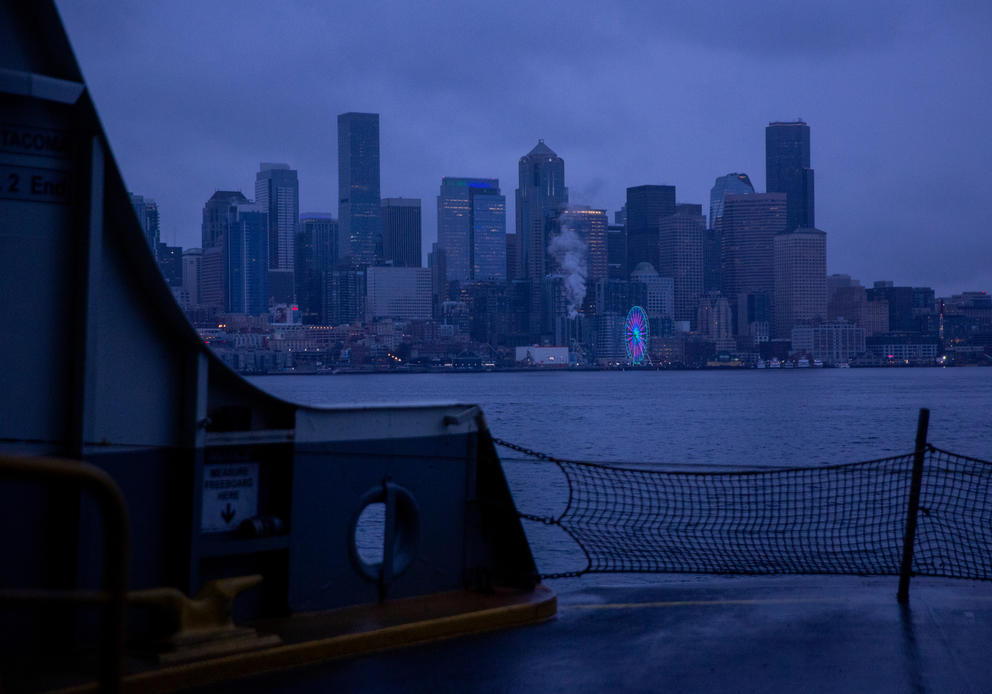Goodrich, an elementary school teacher and single parent who lives in Friday Harbor, has received chemotherapy and radiation as part of an experimental clinical trial after being diagnosed with liver cancer earlier in the year.
Luckily, she did end up making it to Seattle, but only after booking a Kenmore Air seaplane flight that cost $170 and then hiring an Uber — something Goodrich, as an immunocompromised person, wasn’t eager to do during a pandemic.
The causes of the current crisis in the ferry system, part of the Washington State Department of Transportation, are various and complicated. Ever since the passage of Initiative 695 in 1999, which slashed revenue from car tabs, the state’s ferry system has been chronically underfunded. Its fleet of boats is aging and in constant need of repair. In the decade between 2000 and 2010, not a single new ferry was built. And in December, the M.V. Tillikum, which was built in 1959 and serves the San Juans, where Goodrich lives, was pulled from service for electrical repairs.
As bad as the geriatric fleet is, the ferry system’s dwindling workforce is its most troubling problem — and one that won’t be fixed easily or quickly.
According to the latest figures from Washington State Ferries, 12% of its employees are currently eligible to retire, and within the next five years, 26% will be eligible. This attrition has been exacerbated by a pandemic, which has pushed other staff out the door. And replacing these skilled workers is no fast or simple matter for the ferry system.
“The biggest driver [in cancellations] right now really is the staffing issue,” said Dale Bateman, who leads the Seattle Maritime Academy, a part of the Seattle College system and a common training ground for maritime staff in the state ferry system. “There aren’t enough folks in some of the trained positions to fully staff the total number of runs that would normally be scheduled.”
In addition to usual retirements, a significant number of ferry employees have either quit, retired or been fired because they refused to get COVID-19 vaccinations. According to Ian Sterling, a spokesperson for Washington State Ferries, 139 employees have left for COVID-related reasons. In the course of two years, ferry staffing levels have dropped from about 1,900 to 1,769.
Because many of these jobs are extremely specialized and require extensive training and Coast Guard certification, the prospect of quickly recruiting new crew members is especially daunting. Training for many positions can require up to 360 days of sea time, meaning at least two years of apprenticeship.
Route cancellations in the state ferry system have been rising since April of this year, but reached a peak this fall. In the first half of October, 341 runs were canceled because of crew shortages — an unprecedented number. Cancellations declined to 45 between mid-October to the end of November, but that’s largely due to dramatic reductions in the number of scheduled runs, Sterling said.
The impacts for residents of the San Juans, who have no option other than private boats or flights to get on and off the island, have been immense.
Grocery stores shelves have been bare of even basic necessities such as bread and milk, said San Juan Island resident Meredith Griffith. Griffith, a cancer survivor with chronic medical issues, said she often has to wake her young children at 4 a.m. and sit in the car for long hours in the hopes of catching a rare ferry run to the mainland for medical appointments or groceries.
“Elderly and ill people in our community are forgoing needed medical care,” Griffith said in an email, “rather than risk having to sleep in their cars in the bone-numbing, bitter winter cold.”
Island businesses have also taken a hit. Andy Derksema, owner of a salmon fishing charter boat company based in Friday Harbor, said the uncertainty of ferry cancellations has caused a precipitous drop in the number of clients. “In the months between May and September we lost over $10,000 in business,” Derksema said. “It’s a confidence issue for our customers. The whole ferry system is flawed.”
In response to the ongoing crisis, state legislators from the 40th Legislative District, which includes the San Juan Islands and Anacortes, have created a ferry caucus to lobby for significant funding increases.
A Washington State Ferries worker moves a traffic cone out of the way on a Seattle-Bainbridge Island ferry in preparation for arrival in Seattle, Jan. 5, 2022. According to the latest figures from Washington State Ferries, 12% of its employees are currently eligible to retire, and within the next five years, 26% will be eligible. This attrition has been exacerbated by a pandemic, which has pushed other staff out the door. (Lindsey Wasson for Crosscut)
“The ferry system has not been a transportation priority in the last 20 years,” said 40th District Rep. Debra Lekanoff, a member of the caucus. Her coalition recently sent an open letter to Gov. Jay Islee imploring him to adequately fund ferries. “If you don’t invest in your infrastructure, it’s going to fall apart,” she said. “You buy a house and don’t put the right gutters in, it’s gonna destroy everything down below.”
The governor seems to be getting the message. Inslee recently announced his 2021-2023 budget proposal, which includes an increase of about 5% in the portion of Washington State Ferries’ operating budget that includes staffing, said Jordan Kronen, a spokesperson for state Sen. Liz Lovelett, another member of the ferry caucus.
Inslee’s proposed 2021-2023 capital budget for Washington State Ferries represents a 26% increase ($131 million), compared with the current two-year budget ($505 million). If unspent money from the 2019-2021 biennium is added to that figure, Inslee’s ferry system capital budget represents a 44% boost to be spent on new ferries and terminals. This includes $91 million that’s part of Inslee’s new climate agenda, which would pay for two additional electric hybrid ferries and terminal electrification.
Although state ferries get a significant subsidy from various tax revenues, the lion’s share of the system’s operating budget is covered by fares — of $540 million in the proposed 2021-2023 operating budget, $390 million, or 72%, comes from ticket sales. But both ridership and fare revenue have declined during the pandemic, in part because of cancellations. Sterling, the ferry spokesperson, said the pandemic has resulted in a loss of more than $142 million in ticket sales since 2020.
As pressing as funding issues are, it’s clear the ferry system’s problems go back at least a decade, as state transportation officials and lawmakers have failed to train and replace the aging workforce.
Tim Saffle is a retired Washington State Ferry captain with 35 years of experience. He now leads the Pacific chapter of the International Organization of Masters, Mates & Pilots, the union that represents ferry deck officers. Safffle said ferry administrators have known about the impending aging workforce crisis since as early as 2008.
Prior to 2009, the ferry system hired 11 new deck officers on average each year through internal training programs, according to Saffle. After Washington State Ferries eviscerated funding for those training programs in 2009, that number plummeted. “We went through a five-year period after that where we only had five new mates total,” Saffle said.
In 2014, the union did a survey of its members. “We came up with a bell curve showing that the ferry system was going to peak out in about 2018 or 2019,” he said. “We told them we need to be training more people.”
The U.S. Coast Guard has strict requirements regarding the minimum number of crew members each vessel must have in order to sail. For instance, the Seattle-Bainbridge run generally requires, at a minimum, a captain, two mates, four able seamen and a chief engineer, among others. With crews on most runs at a bare minimum, it sometimes takes only one person calling in sick to force a cancellation. Add to that an aging and inefficient on-call and dispatch system and ferries are often without the necessary staff. Throw a pandemic into the mix, and you have a perfect storm.
“There was already a significant systemic stressor on the system, and WSF was kind of muddling through,” said Bateman of the Seattle Maritime Academy. “COVID significantly exacerbated that, but it also kind of masked it because there were few people sailing.”
The problem of crew shortages and cancellations isn’t limited to Washington State Ferries. Across the globe, the maritime industry is confronting an aging and shrinking workforce that has intensified during the pandemic. Saffle said the Alaska Marine Highway system and BC Ferries are also struggling with labor shortages that aren’t expected to improve any time soon.
The retirement crisis is most alarming in the senior ranks at Washington State Ferries. “For our most senior deck officers and senior engine room staff [the number eligible for retirement] is sometimes as high as 50% or more,” Sterling said. Bateman noted that the average age of mates and senior staff in Washington State Ferries is 55.
Internal staffing policies haven’t helped the ferry system, Bateman said. In addition to having minimal funding for internal training and recruiting, the on-call and apprenticeship programs discourage the deckhands who park cars and clean bathrooms from wanting to advance into the upper ranks because those who want to train for those higher level positions must revert to on-call status.
“In many cases, if I want to advance I’m dropping to on-call from a fairly senior status as an AB [able-bodied seaman] making decent money with a fairly routine schedule,” Bateman said. “Because I’m senior in the union I get control over the routes I’m working. But if I become a mate…. My life suddenly gets upended.”
Patty Rubstello, who was appointed to her position as assistant secretary of the Washington State Ferries in 2020, said the agency is looking at changes to this system. “There’s a lot of dedication within the ferries that want to provide quality, reliable service, but sometimes there are things that are out of our control,” said Rubstello. She noted that the ferry system is working to fix the on-call practice, recognizing that its unpredictable nature makes it unworkable for many of its employees.
Rubstello wouldn’t commit, however, to a timeline for those changes. She also said the agency hopes to ramp up recruitment efforts at national maritime academies and to diversify its pool of applicants. But she also didn’t offer a timeline for meeting the system’s diversity goals.
Rubstello said Washington State Ferries seeks to ramp up staffing on boats above Coast Guard limits, but added that without significant budget increases in the upcoming legislative session, this will prove difficult. “That would require more than the Legislature has given us in the past,” she said.
Sterling, the ferry system spokesperson, said one systemic improvement that has made is switching to year-round recruitment and hiring. Traditionally, the ferry system hired only before the busy summer season. “There are ferry jobs to apply for right now,” he said. “That’s not something that was the case pre-pandemic.”
Schools such as the Seattle Maritime Academy offer a quicker route to these highly specialized positions, said Bateman. The academy’s training programs for deck crews and engineers take about nine months of classroom instruction and hands-on training, and this can reduce the required sea time working on state ferries to about 90 days in some cases.
Unfortunately, apprenticeship programs within the ferry system are poorly paid, offering just a $50 to $75 daily stipend, Bateman said. Upping that pay or increasing scholarships for maritime schools in the state could help. Currently, the Seattle Maritime Academy graduates about a dozen students each in its deck and engineering programs each year, although it has capacity for 18 in each program and could ramp up to about twice that number if more funding were available.
To encourage more young people living in San Juan County to seek maritime careers, the San Juan Island Economic Development Council this year launched a program that helps prepare students for Coast Guard exams for pursuing general maritime careers, as well as assisting with transportation to maritime programs at Skagit Valley College on the mainland.
“It’s a super grassroots, nitty-gritty effort,” said executive director Victoria Compton. “If we need to do a bake sale to support it, we will.”
For Lisa Coley, who lives on Vashon Island, ferry cancellations have thrown her work life into chaos. A clinical social worker who contracts at six different hospitals in Kitsap County and Tacoma, Coley has had to dramatically reduce her hours because of erratic ferry service. “For the people who commute to Tacoma, it’s causing true hardship,” Coley said. “It’s not just an inconvenience.”
Because Vashon is served by two ferry runs, the agency has sometimes canceled a complete day of sailings between Point-Defiance and Tacoma, arguing that the island still has the other “triangle run” connecting Southworth and West Seattle. Coley said those Tacoma cancellations have sometimes left her teenage son, who attends high school in Tacoma, stranded on the other side. Fortunately, he has friends he can stay with, but Coley is fed up. She is considering buying a house on the mainland after 14 years on the island.
“I’ve attended all the meetings when they had them on the island,” Coley said. “But you get burned out over time because nothing ever changes. ... It actually gets worse.”

